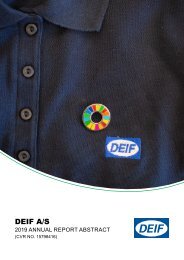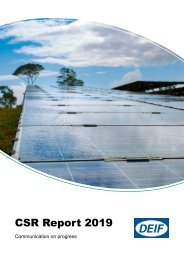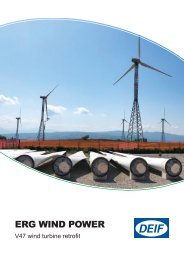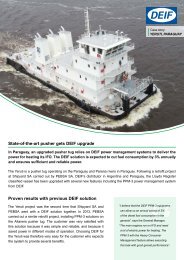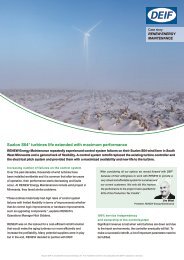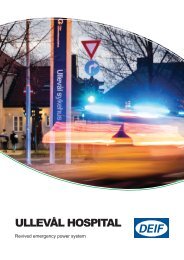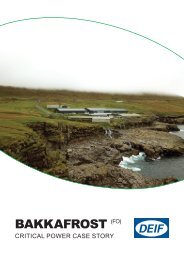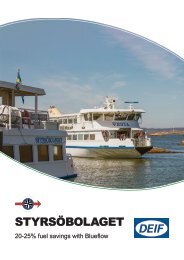Case study: Ferries of the future save 65% CO2
In a major project co-financed by the European Union, the M/F Tycho Brahe and M/F Aurora are still equipped with their original diesel-powered engines, but four containers on each top deck hold the equivalent of about 4160 kilowatt hours (kWh) of electrical power: 640 lithium batteries, with 11 megawatt (MW) total.
In a major project co-financed by the European Union, the M/F Tycho Brahe and M/F Aurora are still equipped with their original diesel-powered engines, but four containers
on each top deck hold the equivalent of about 4160 kilowatt hours (kWh) of electrical power: 640 lithium batteries, with 11 megawatt (MW) total.
- No tags were found...
Create successful ePaper yourself
Turn your PDF publications into a flip-book with our unique Google optimized e-Paper software.
TYCHO BRAHE<br />
HYBRID FERRY CASE STORY
HENRIK FALD HANSEN<br />
Senior Chief Engineer on <strong>the</strong> M/F Tycho Brahe, stands among<br />
hundreds <strong>of</strong> lithium batteries that power <strong>the</strong> ferry across <strong>the</strong><br />
Øresund Strait between Denmark and Sweden.<br />
FERRIES OF THE FUTURE<br />
SAVE <strong>65%</strong> CO 2<br />
In <strong>the</strong> strait between Denmark and Sweden, two ferries are leading <strong>the</strong> way to tomorrow’s marine transportation.<br />
In a major project co-financed by <strong>the</strong> European Union, <strong>the</strong><br />
M/F Tycho Brahe and M/F Aurora are still equipped with<br />
<strong>the</strong>ir original diesel-powered engines, but four containers<br />
on each top deck hold <strong>the</strong> equivalent <strong>of</strong> about 4160 kilowatt<br />
hours (kWh) <strong>of</strong> electrical power: 640 lithium batteries, with 11<br />
megawatt (MW) total. Charging is done with up to 11 MW.<br />
The ships can run on full battery, full diesel or a combined,<br />
hybrid set-up. They are two out <strong>of</strong> four ferries running <strong>the</strong><br />
busy route between Elsinore (Helsingør), Denmark, and<br />
Helsingborg, Sweden, a yearly total <strong>of</strong> 50,000 times – and<br />
with 7.2 million passengers. The ships’ owner, HH <strong>Ferries</strong>,<br />
thus <strong>save</strong>s <strong>65%</strong> CO 2<br />
emissions on its battery-sailed initiative.<br />
2
“We would really like to be a green shipping company, and<br />
we want to do something for <strong>the</strong> environment,” says Henrik<br />
Fald Hansen, Senior Chief Engineer on <strong>the</strong> M/F Tycho Brahe.<br />
“This is our contribution.”<br />
The ferries charge <strong>the</strong> batteries with electricity coming from<br />
renewable-generation in Denmark and Sweden – such as<br />
wind, hydro and solar. Thus, when <strong>the</strong> ferries run on battery<br />
power alone, <strong>the</strong>y are nearly 100% <strong>CO2</strong>-free, says Henrik<br />
Fald Hansen. They both use DEIF Delomatic 4 systems for<br />
power management.<br />
“These are <strong>the</strong> ferries <strong>of</strong> <strong>the</strong> <strong>future</strong>,” he says.<br />
3
THREE MODES<br />
WITH DEIF<br />
When HH <strong>Ferries</strong> was re-tooling <strong>the</strong> ships with<br />
batteries in 2017, it needed a power management<br />
system that could handle <strong>the</strong> three operating<br />
modes: diesel, battery or hybrid. Tycho Brahe was<br />
already running with a DEIF power management<br />
system since 2013, so DEIF was to upgrade that<br />
to a Delomatic 4 for diesel-electric propulsion.<br />
“A diesel, “old-fashioned” mode simply operates<br />
gensets and main propulsion <strong>the</strong> usual way”,<br />
says Per Ole Sørensen, Team Manager in DEIF’s<br />
Marine & Offshore System Solutions Department.<br />
The power management system calculates and<br />
controls <strong>the</strong> load onboard <strong>the</strong> vessel, telling <strong>the</strong><br />
main propulsion how much power is available.<br />
A battery-powered operation must work similarly<br />
but collects data from <strong>the</strong> batteries’ own<br />
management system. It calculates how much<br />
discharge capacity is available and <strong>the</strong> max power<br />
needed, again making sure <strong>the</strong> main propulsion<br />
is not overloading <strong>the</strong> system.<br />
And <strong>the</strong>n <strong>the</strong> ship’s operator – or <strong>the</strong> system<br />
itself – can initiate <strong>the</strong> hybrid mode. If <strong>the</strong> energy<br />
level in <strong>the</strong> batteries is low, <strong>the</strong>n it must start up<br />
a diesel genset and operate in parallel with <strong>the</strong><br />
batteries. The main propulsion can even charge<br />
<strong>the</strong> batteries until <strong>the</strong> ship reaches harbour.
Henrik Fald Hansen, Senior Chief Engineer<br />
on <strong>the</strong> M/F Tycho Brahe, in front <strong>of</strong> <strong>the</strong> DEIF<br />
power management system cabinets.
FAST & POWERFUL<br />
RECHARGE<br />
The batteries on board can propel <strong>the</strong> Tycho Brahe 3.5 times between<br />
harbours, but <strong>the</strong> ship recharges every time.<br />
“We are on <strong>the</strong> world’s largest battery-powered ship,” Henrik says. “We<br />
recharge with 10-11 MW at harbour with high-voltage lines.” When <strong>the</strong><br />
ship comes to dock, a robot arm carefully “plugs in” <strong>the</strong> high voltage<br />
line to <strong>the</strong> side <strong>of</strong> <strong>the</strong> ship. “We have five and a half minutes to charge<br />
in Denmark and nine minutes to charge in Sweden – so it’s got to go<br />
quickly.”<br />
Due to <strong>the</strong> high volatility <strong>of</strong> lithium batteries in <strong>the</strong> containers, HH <strong>Ferries</strong><br />
has installed a double (redundant) safety and emergency protection<br />
system, which includes a water-cooling system for <strong>the</strong> batteries and<br />
aerosol and water sprinkler systems for <strong>the</strong> containers, he says.<br />
SIDE BENEFIT:<br />
QUIET<br />
When <strong>the</strong> Tycho Brahe sails on battery power, <strong>the</strong> engine room is quiet.<br />
“It’s a completely different working environment,” says Henrik Fald<br />
Hansen. “It’s a strange feeling as a mechanical engineer to have a<br />
machine room that’s quiet. The first time we stopped <strong>the</strong> diesel motors<br />
and sailed on battery, <strong>the</strong> hair on my arms stood up. It’s fantastic.<br />
It’s so impressive to see that batteries can power so large a<br />
ship. We get a completely peaceful and quiet place to work.<br />
“This is an innovative project,” he adds. “Electrical propulsion is <strong>the</strong> <strong>future</strong>.<br />
I’m proud to be a part <strong>of</strong> <strong>the</strong> world’s largest battery-driven ship, and part<br />
<strong>of</strong> such a large project. It has been a lot <strong>of</strong> work, but <strong>the</strong>re are so many<br />
things we can be proud about.”<br />
6
At dock, <strong>the</strong> M/F Tycho Brahe, recharges its<br />
batteries with high-voltage cables. The whole<br />
process <strong>of</strong> transferring up to 11 MW <strong>of</strong> power<br />
takes from five to nine minutes.<br />
7
Diagram and technical description<br />
From AC diesel-electrical propulsion to diesel, hybrid & battery operation<br />
2<br />
1<br />
4<br />
4<br />
Standard 3D model <strong>of</strong> a ferry<br />
3<br />
DEIF 21”<br />
Graphic interface<br />
2<br />
Battery<br />
2 Battery<br />
2 Battery<br />
2<br />
1<br />
Battery<br />
DM-4<br />
=<br />
=<br />
DM-4<br />
=<br />
=<br />
DC BUS BAR<br />
DM-4<br />
=<br />
=<br />
DM-4<br />
=<br />
=<br />
3<br />
= =<br />
~ ~<br />
3<br />
= =<br />
~ ~<br />
= =<br />
= =<br />
3 ~ ~ 3 ~ ~<br />
Main<br />
propulsion<br />
Main<br />
propulsion<br />
Main<br />
propulsion<br />
Main<br />
propulsion<br />
AC BUS BAR<br />
4 Genset<br />
4<br />
Genset<br />
4 Genset<br />
4<br />
Genset<br />
DM-4<br />
DM-4<br />
DM-4<br />
DM-4<br />
REDUNDANT DEIF NETWORK<br />
8
Facts<br />
DEIF’s solution installed on board M/F Tycho Brahe<br />
Installed power supply specs<br />
► 4 x 2.6 MW Wärtsila diesel gensets<br />
► 11 MW batteries placed in 4 sun deck containers<br />
DEIF power control units installed<br />
► 8 x DM-4 power management units<br />
► 1 x AGI monitoring and control touch screen<br />
Features and benefits<br />
► 4 x 2.6 MW Wärtsila diesel gensets<br />
► 11 MW batteries placed in 4 sun deck containers<br />
► Diesel, hybrid and battery operation possible<br />
► Optimsed genset load in hybrid mode<br />
► Full charge/discharge battery control<br />
► Automatic transfer from battery to hybrid<br />
► Redundant communication – fibre-optical cables<br />
► Thruster reduction based on battery energy status<br />
AGI touch screen<br />
► State-<strong>of</strong>-<strong>the</strong>-art HMI<br />
► Multi-touch widgets<br />
► Advanced programming tool<br />
► Data-logging and alarm handling<br />
► Complimentary DEIF app templates<br />
► Multiple remote options<br />
► Phone/tablet compatible<br />
► Pinch zoom<br />
► Designed for harsh marine environments<br />
► Available in 7", 10", 15" and 21" sizes<br />
DM-4 power management solution<br />
► Internal system supervision<br />
► Engine control, monitoring and protection<br />
► 3-phase generator protections<br />
► Automatic synchronisation<br />
► Load sharing<br />
► Dual ARCnet bus communication lines for<br />
redundancy<br />
► Multiple display units and multiple Advanced<br />
Operator Panels<br />
► Interface to <strong>the</strong> DEIF advanced graphical touch<br />
screen AGI<br />
► 2 × Integrated RS-485 Modbus communication<br />
port<br />
► 2 × CAN bus port for J1939 engine supervision,<br />
CANopen<br />
► USB port for service s<strong>of</strong>tware<br />
► Up to 690 V AC direct AC inputs<br />
► Alarm and event log<br />
► Advanced load-dependent start/stop calculations<br />
► Blackout prevention and recovery<br />
► Priority selection<br />
► Heavy consumer handling<br />
► Base load function<br />
► Trip <strong>of</strong> non essential load groups (preferential trip)<br />
► Advanced fuel optimisation features<br />
► One-touch auto sequences<br />
► Dynamic positioning (DP-2) operation with closed<br />
bus tie breaker<br />
► Fast dynamic load-share deviation protection<br />
► Fast thruster load reduction<br />
► Optimised load sharing<br />
► 1 × Modbus TCP/IP<br />
► Service s<strong>of</strong>tware via e<strong>the</strong>rnet for remote access<br />
9
NOT JUST POWER. ENERGY.<br />
“With <strong>the</strong> batteries, you have more <strong>of</strong> an ‘energy<br />
management system,’” Per Ole says. “It’s not<br />
only <strong>the</strong> power anymore. Your system has to be<br />
able to monitor <strong>the</strong> energy left in <strong>the</strong> batteries.<br />
Are we going to use all that energy in a moment?<br />
Then it will start up a genset and run in hybrid<br />
mode.”<br />
Henrik Fald Hansen says that when <strong>the</strong> Tycho<br />
Brahe installed <strong>the</strong> previous DEIF system in<br />
2013, <strong>the</strong> ship’s crew had to get used to it. “Could<br />
we rely on it? We have just been really, really<br />
satisfied in <strong>the</strong> way <strong>the</strong> DEIF system handled<br />
problems for us. We could trust it.<br />
If <strong>the</strong>re was a generator that wouldn’t start or<br />
something like that, <strong>the</strong> DEIF system took care<br />
<strong>of</strong> it. And we’ve had <strong>the</strong> same feeling after<br />
installing <strong>the</strong> batteries and new DEIF system.<br />
We have definitely been confident that DEIF can<br />
handle things when <strong>the</strong>re are any problems.”<br />
ABOUT HH FERRIES<br />
HH <strong>Ferries</strong> Group owns <strong>the</strong> ferry route between<br />
Helsingborg and Elsinore, which is marketed<br />
under <strong>the</strong> trademark Scandlines Helsingborg-<br />
Elsinore. The four ferries depart every 15<br />
minutes, transporting up to 50,000 passengers<br />
and 9,000 cars as well as 1,600 buses and<br />
trucks cross Oresund on a daily basis. 7.2 million<br />
passengers a year over <strong>the</strong> Øresund Strait.<br />
The company has converted two <strong>of</strong> its ferries –<br />
<strong>the</strong> M/F Tycho Brahe and <strong>the</strong> M/F Aurora – to<br />
run on battery, hybrid or diesel propulsion.<br />
That is expected to reduce <strong>the</strong> total <strong>CO2</strong><br />
emissions from HH <strong>Ferries</strong> by <strong>65%</strong>.<br />
“We have been really, really<br />
satisfied in <strong>the</strong> way <strong>the</strong> DEIF system<br />
handles problems for us. We trust it.”<br />
Henrik Fald Hansen<br />
Senior Chief Engineer<br />
M/F Tycho Brahe
Henrik Fald Hansen, Senior Chief Engineer on<br />
<strong>the</strong> M/F Tycho Brahe, in front <strong>of</strong> <strong>the</strong> DEIF power<br />
management system cabinets.<br />
11
The M/F Tycho Brahe sails into dock at Elsinore,<br />
Denmark. A robotic arm is housed in <strong>the</strong> structure<br />
on <strong>the</strong> left. It plugs <strong>the</strong> high-voltage cable into <strong>the</strong><br />
battery recharging station on <strong>the</strong> ship.<br />
DEIF A/S<br />
Frisenborgvej 33, 7800 Skive, Denmark<br />
Tel. +45 9614 9614<br />
Learn more at www.deif.com





